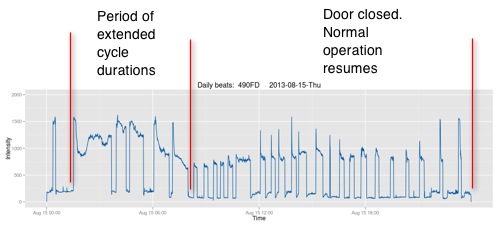Summary
Refrigeration faults aren’t always blamed on the condenser or evaporator. Sometimes there is a perfectly good explanation and a cheap fix. This article shows the effect on cycle times when a walk-in refrigerator door was accidentally left open overnight after a produce delivery.
Key Concepts
Virtjoule detects extended cycle times that can be due to problems with the walk-in cooler box itself.
When door seal gaskets wear out and doors need an adjustment, the unit will have to work harder to make up for heat leaking into the cooler.
The first chart shows the normal cycle pattern for this Heatcraft HyperCore. Cycle times are between 8 and 15 minutes long and the unit cycled 33 times.
The next day, in the early morning hours, the unit began a very long 3 hr and 40 minute cycle followed by a 33 minute cycle, a 47 minute cycle, and two 52 minute cycles. By that time the morning crew figured out the cause of the problem and got the door closed.
Virtjoule caught this problem through the use of cycle duration rules and recognizing several extended duration cycles. No crisis call was made to this client because of the early morning time and the fact that the unit was still cycling.
When we see a unit extend cycle times like this, but still cycle off and on, we can safely assume the unit is still meeting demand. It’s obviously taking a lot longer to meet the demand and the unit should be looked at.
The fix in this case was cheap and obvious…close the door. Other situations could be more insidious. Walk-in refrigerator doors are used a lot. Door seals wear out. Hinges sag. Latches break. When door seals start to fail or the door doesn’t fit as well, it can be hard to know.
When you’re monitoring the cycle count and cycle durations, you can see the unit begin to work harder and harder to make up for the cooling loss.


